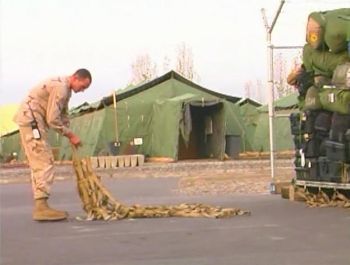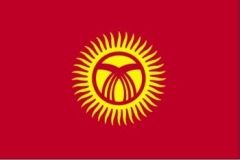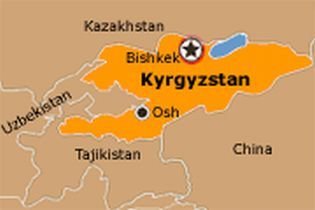
Publisher:
Bonnie King
CONTACT:
Newsroom@Salem-news.com
Advertising:
Adsales@Salem-news.com

~Truth~
~Justice~
~Peace~
TJP
Jan-01-2012 14:23

 TweetFollow @OregonNews
TweetFollow @OregonNews
The Manas Question: Drugs, Revolution and Terrorism
James Corbett Special to Salem-News.comFor years the Manas air base near the central Asian republic of Kyrgyz capital of Bishke has been at the centre of a string of allegations revolving around drug-running, terrorism and stage-managed revolutions.
 Mannas, Kyrgyzstan photo by Tim King Salem-News.com |
(MANAS, Kyrgyzstan) - The Manas Air Base, situated near the Kyrgyz capital of Bishkek, Afghanistan, has played a key role in the increasingly important Central Asian region since its inception.
First opened in December 2001 to support the US-led invasion of Afghanistan, the Manas Air Base plays host to the US Ninth Air Force and serves primarily as a transit point for US goods and personnel coming and going from Afghanistan.
As part of the so-called Northern Distribution Network, a key supply route for NATO troops in Afghanistan that bypasses the now-blockaded Pakistani borders, Manas continues to be a strategically vital asset for the US. At the same time, the base has also been a point of contention with the locals for years, and the controversy doesn’t seem likely to die down any time soon.
The base’s deep unpopularity with the local Kyrgyz people has been a leverage point for successive administrations in their negotiations with the Americans for the continued use of the facility. Just last month, the newly-elected president of Kyrgyzstan, Almazbek Atambayev, said that his government will once again be seeking the bases closure in time for the United States supposed 2014 pullout from Afghanistan.
But as important as the base is to the Kyrgyz people, the true nature of Manas remains an open question. For years, it has been at the centre of a string of allegations revolving around drug-running, terrorism and stage-managed revolutions.

One of the most surprising revelations to emerge from Manas centered around the story of Abdolmalek Rigi, the former leader of the Jundullah terrorist organization who was captured by Iran onboard a flight from the United Arab Emirates to Kyrgyzstan.
Jundullah is a Pakistani tribal militant group that concerns itself with plight of Sunni Muslims in the predominantly Shiite Iran. Despite widely-acknowledged links to al-Qaeda, the CIA has been funding the group for years as a proxy force to commit attacks inside Iran, where it is believed to have killed and injured over 500 civilians since 2003.
As Rigi himself told his Iranian captors, his story included the air base at Manas, which he claims the US uses to conduct covert meetings with people like himself.
Last year, Global Research Associate Peter Dale Scott wrote a lengthy article outlining how US intervention in Kyrgyzstan in the name of protecting its strategic air base, has led to the destabilization of Kyrgyz politics and to a drastic increase in the flow of drugs through the country.
In 2005, Kyrgyzstan’s own colour revolution, the so-called Tulip Revolution, brought Kurmanbek Bakiyev into power. According to Kyrgyz political commentators, the entire Bakiyev family was involved in drug trafficking, and they used the opportunity to kill off competing drug lords and consolidate the lucrative business of trafficking Afghan heroin. In October 2009, Bakiyev abolished the Kyrgyz Drug Control Agency and the already steady flow of narcotics in the country continued to increase.

In addition, there has been much speculation about the true nature of the Tulip Revolution itself. Although it did represent a popular uprising against a corrupt and increasingly unpopular leader, this was by far the bloodiest of the colour revolutions, with the new leader coming to power on the backs of over 360 wounded civilians.
The Bakiyev government that stepped in to take over was a highly coordinated, and some say covertly directed, coup faction that left even Edil Baisalov, one of Kyrgyzstan’s premier democracy advocates, lamenting “Let’s not pretend that what happened here was democratic.”
The timing of the revolution itself was suspiciously fortuitous for the United States, which had enjoyed good relations with Akayev from the time of the opening of the Manas base in 2001 until October 2003, when Akayev allowed the reopening of an old Soviet base in Kant by the Russians in the name of combating terror in neighboring Uzbekistan and Tajikistan. Kyrgyzstan was immediately put on the US State Department’s watch list, and aid increased to Kyrgyz opposition groups via a number of American-based NGOs.
According to Der Spiegel, Roza Otunbayeva, a Kyrgyz politician who took over the Presidency after Bakiyev himself was ousted in 2010, pledged her support during the time of the Tulip Revolution “to ‘our American friends’ at Freedom House (who donated a printing press in Bishkek to the opposition), and to George Soros, a speculator who previously helped unseat Edward Shevardnadze’s government in Georgia.”
Earlier this week I had the chance to talk to Justin Burke, the Managing Editor of the Eppy Award-winning website, Eurasianet, which is funded by the George Soros-founded Open Society Institute, about the allegations that the Tulip revolution was manipulated by outside interests.
Regardless of the nature of the base and its involvement in various covert US military operations in the greater Afghan theatre, it is indisputably a lightning rod for controversy, a point of contention with the Kyrgyz government, and a thorn in the side of Russia, which fears the spread of NATO influence in an area that it has traditionally considered its back yard.
Last week I talked to Rick Rozoff of Stop NATO International about the base and how it will potentially be used in the future. I began by asking him whether he takes the incoming Kyrgyz presidents’ latest threats to close the base seriously given how many times the base’s closure has been talked about in the past.
Ultimately the question of the Manas Air Base, or the Transit Facility at Manas, as the US hopefully renamed it in its latest round of negotiations with the Kyrgyz government, is not a small question about an isolated Central Asian state of questionable democratic abilities. The question is the much greater one of struggle for the region as a whole, and it involves not only the US, but Russia, China, and a host of nations with a toehold in this geostrategically vital section of the globe.
As both a founding member of the Shanghai Cooperation Organization and a participant in the Organization for Security and Cooperation in Europe, the regional security organization that is seeking to bring together the regional players on contentious matters before the anticipated NATO pullout from Afghanistan in 2014, Kyrgyzstan is straddling a fault line in the tectonics of geopolitics. And like any other fault line, it is an area of danger and uncertainty perhaps best represented by the Manas base itself, which continues to be the focus of scandal, controversy, and potential future conflict in the region.
Special thanks to the Kali-Yuga-Report
 |
 |
 |
 End Israel's Unwarranted Murder of Kids |
Articles for December 31, 2011 | Articles for January 1, 2012 | Articles for January 2, 2012





Salem-News.com:
Terms of Service | Privacy Policy
All comments and messages are approved by people and self promotional links or unacceptable comments are denied.
[Return to Top]
©2025 Salem-News.com. All opinions expressed in this article are those of the author and do not necessarily reflect those of Salem-News.com.